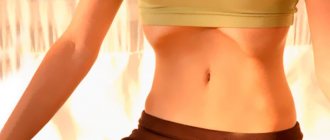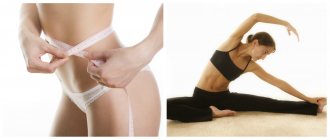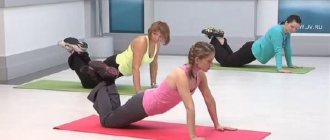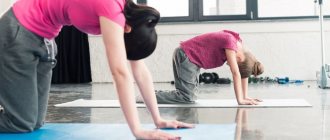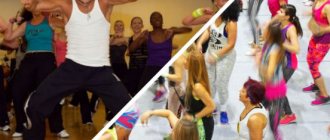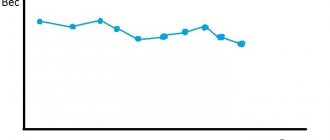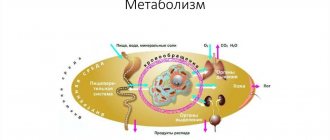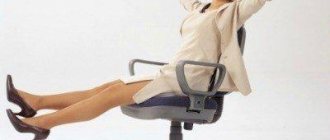Some go on a strict diet, others exhaust themselves with high activity training, and still others take drugs to lose weight. Among those who dream of being slim, another separate trend has begun to gain popularity - bodyflex breathing exercises. Supporters of this exotic are sure that to lose weight it is enough just to perform special exercises in combination with special breathing.
So, what is bodyflex? Is it really effective? After all, if so, then maybe it would be worth promoting it more actively to the masses? Let's look at it in more detail in this article.
Key principles of breathing exercises
A set of bodyflex exercises (from the English “body” - body, “flex” - flexible) is a weight loss system that combines poses from yoga, stretching, Pilates, and special deep “diaphragmatic” breathing. It is believed that due to increased saturation of cells with oxygen, metabolic processes are accelerated, fat burning is activated, and weight loss is achieved.
The author of the technique, American housewife Greer Childers, claims that in this way she was able to lose 20 kg, as well as improve the condition of her skin and increase her body tone. She explains that breathing techniques are based on the balance of oxygen intake and carbon dioxide production. Due to this, there is a slight increase in blood pressure, increased sweating, and certain chemical reactions are triggered that help speed up metabolism and the breakdown of fat molecules. Greer Childers also says that changing your diet and other weight loss techniques is not necessary. All you need to do is breathe correctly.
There are the following key principles of breathing exercises:
- you need to calm down, slow down your breathing, concentrate on it;
- take a slow deep breath, feel how the lungs expand from the intake of oxygen;
- purse your lips into a tube, exhale slowly;
- take a strong sharp breath through your nose, keeping your lips closed. In this case, the stomach should be inflated and protruded as much as possible;
- open your lips and exhale through your mouth with the sound “PAH”. The lungs should be as empty as possible, and the stomach should stick to the inner wall of the spine;
- it is necessary to retract the stomach as much as possible, directing the muscle contraction from bottom to top, towards the ribs. You need to stay in this position for 8-10 seconds;
- During this breath-holding exercises are performed.
Reviews from supporters of the technique vary. But for the most part, their opinions are unanimous - breathing exercises can be an addition to a course of weight loss, proper nutrition, and psychotherapy to improve eating habits. But as an independent means of getting rid of extra pounds, bodyflex, alas, cannot bring noticeable and, most importantly, stable results.
What happens to the body
The creator of the technique, Greer Childers, promises the following positive effects on the body:
- acceleration of metabolism, metabolic processes;
- improved well-being, relief from fatigue, apathy;
- improved blood circulation;
- increase in energy level, tone;
- removal of waste and toxins due to increased sweating;
- reduction of fat around organs (visceral);
- strengthening the immune system, increasing resistance to viruses and infections;
- strengthening the muscle corset, especially the abdominal muscles (due to diaphragmatic deep breathing);
- improving the functioning of internal organs.
Regular exercise really helps saturate the brain with oxygen. Supporters of the system note an increase in performance and an increase in mental capabilities. In addition, deep breathing can help combat smoking. But interest in bodyflex is caused by the question of its effectiveness specifically for weight loss. Let's continue our discussion of the topic...
Standing body bends
Stand facing the wall at a distance of 20-25 cm from it, stretch your arms up, press your palms tightly against the wall. Lean your body forward slightly, opening your chest, and relax your lower back. Gently lean your body to the left, bending your left arm, and with your straightened right arm, describing a semicircle along the wall. Then just as smoothly lean to the right, bending your right arm and describing a semicircle along the wall with your left. This is one repetition. Perform 5-10 repetitions of the exercise.
While doing gymnastics, observe your sensations. If your health allows, you can increase the number of repetitions. If you feel weak, reduce it.
A set of 10 breathing exercises for weight loss
A similar breathing technique has been used in Indian culture for many years, it is called uddiyana bandha.
The main thing when performing exercises is to combine them with the key principles of breathing:
- After drawing in your stomach, without inhaling, you need to take a pose. Fix it for 8-10 seconds.
- At the end of this time, you need to take a deep breath and move on to the next pose.
If you are interested in the intricacies of this technique, then today the Internet is full of special video lessons and entire courses where this technique is explained in detail. Let's look at a set of basic exercises.
Exercise Diamond
The Diamond exercise is designed to strengthen the arm muscles and reduce fat deposits in the shoulders and forearms. Technique:
- You need to take the starting position: stand straight, spread your legs shoulder-width apart, bring your arms in front of you. Keep your elbows high and touch your fingertips at chest level.
- Inhale, exhale deeply with the sound “PAH”. Pull in your stomach. Record the delay.
- While holding your breath, press your fingertips against each other, resisting this effort. Tension should be felt in the forearm and shoulder area.
Only your fingertips should touch each other. There is no need to lower your elbows, otherwise other muscles will be involved in the work. The pose should be held for the same 8-10 seconds.
Pulling your arms back
This exercise helps strengthen the shoulder girdle, arm muscles, and forearms. The technique is largely similar to the previous exercise:
- after holding your breath, you should move your arms straight back;
- Tension should be felt in the biceps area;
- fix this position for 8-10 seconds.
fix this position for 8-10 seconds.
Each exercise should be repeated 2-4-6 times, the number of repetitions depends on the level of physical fitness and endurance. You can complement this pose with dumbbells or a fitness band. If you put in a little more effort, the effect will be more noticeable.
Side stretch
Lateral stretching helps strengthen the muscles of the lateral surface of the body and reduce waist size. The order of execution is as follows:
- initial standing position, legs spread shoulder-width apart;
- The left foot must be placed on the toe, the right hand must be raised up;
- take a deep breath, draw in your stomach;
- bring your right hand closer to your ear, make a slight tilt. You should feel tension in the waist area.
The exercise should be held for 8 seconds. After this, you need to change your arm and leg. It is important to monitor the position of your back; it is not recommended to slouch or bend excessively in the lower back. The arm should not bend, but be straight.
Simple press
An effective exercise for reducing abdominal volume is “Simple Press”. It helps strengthen the abdominal and neck muscles.
- starting position: lying on your back, legs bent at the knees;
- after exhaling, you need to lift your shoulder blades off the floor and hold this position for 8-10 seconds.
There should be a distance between the chin and the chest, otherwise the load on the neck will increase in an undesirable way. You should stretch your arms forward, raising your shoulder blades as much as possible.
Horizontal scissors
Horizontal scissors strengthen the muscles of the lower abdomen, quadriceps, inner and upper thighs.
- starting position: lying on your back, lower back pressed tightly to the floor;
- exhale, pull the stomach in from bottom to top, directing it under the ribs;
- while holding, raise your legs and perform horizontal scissors for 8-10 seconds.
The toes of your feet should be pulled up. The range of movements is small; the exercise should be performed slowly. It is not recommended to lift your head off the floor, as this may undesirably increase the load on the neck muscles.
Vertical scissors
Vertical scissors help strengthen the abdominal muscles; the lower abs are especially actively involved in the work. In addition, the thigh muscles are being worked on.
- starting position: lying on your back, lower back pressed tightly to the floor;
- you need to take a deep breath, pull in your stomach;
- raise your legs 30-40 cm from the floor without lifting your lower back;
- do a vertical crossing of the legs while holding, like scissors.
When performing the exercise, the lower back must be pressed to the floor. If it comes off, you should lower your legs a little lower.
Boat
The Lifeboat exercise helps stretch and strengthen the muscles of the inner thighs.
- starting position - sitting on the buttocks, legs spread as far apart as possible;
- exhale, draw in your stomach;
- lean forward and fix this position.
It is recommended to perform the exercise slowly, without sudden movements. In this case, you need to keep your back straight and pull your toes towards you. You should feel tension in your calves and hamstrings.
Pretzel
The “Pretzel” exercise helps strengthen the muscles of the outer thigh and shape the waist. The creator of the bodyflex system says that this pose significantly reduces the size of the waist and hips.
- starting position: sitting on the floor, legs extended;
- cross your left leg over your right and place it on your foot;
- the foot of the left leg should be next to the knee of the right leg;
- take a breath, draw in your stomach;
- turn to your bent left leg, clasp your knee with your right hand;
- hold for ten seconds.
The bent knee must be pulled towards the chest, twisting as much as possible at the waist.
Dog
The “Dog” exercise is designed to strengthen the muscles of the inner and outer thighs and improve the mobility of the hip joints. Supporters of bodyflex note a decrease in the volume of the hips and the “breeches” area.
- starting position - standing on your knees and hands;
- you need to take a deep breath, pull in your stomach;
- raise your left leg, bent at the knee, to an angle of 90 degrees;
- fix the position for 10 seconds.
You need to do at least four repetitions: two on each leg. When performing the exercise, you should not raise your head: it is better to look at the floor in front of your palms. This will take the strain off your neck.
Cat
The “Cat” exercise helps relax, stretch muscles, and strengthen the back muscles.
- starting position - standing on your knees and palms;
- it is necessary to breathe, hold, and draw in the stomach as much as possible;
- round your back, tilt your head down, relax your neck.
Hold the pose for ten seconds. It is important not to bend too much or raise your head up. This exercise is especially useful for people who lead a sedentary lifestyle - it increases blood circulation and relieves muscle tension.
Who is not suitable for the breathing method?
The creator of the method, Greer Childers, confidently states that bodyflex is suitable for losing weight in the abdomen and sides, strengthening the body, and increasing overall tone. But professional doctors warn supporters of this method: there is an extensive list of contraindications that you need to familiarize yourself with.
Contraindications
Bodyflex is a special program that may not be suitable for everyone. There are a number of contraindications. These include:
- Hypertension, coronary heart disease, cardiovascular dystonia.
- Cardiovascular diseases of a congenital or acquired nature.
- Chronic or acute diseases of internal organs.
- Chronic diseases that are in remission.
- Severe diseases of the visual organs.
- Gastrointestinal tract disorders: unstable stool, flatulence, diarrhea.
- Disturbances of hormonal levels and the functioning of the endocrine system.
- Diabetes.
- Oncology.
- Post-operative rehabilitation: For a year after spinal surgery, this breathing practice is prohibited.
- Disorders of the thyroid gland.
- Phlebeurysm.
As you can see, the list of very serious contraindications is quite extensive. It is clear that only weight loss specialists can take them all into account - and then recommend or not recommend bodyflex. In general, long-term world practice in the fight against obesity shows that for weight loss, complex methods (switching to proper nutrition with the help of psychotherapy) are superior to all other methods. It is this that allows the widest audience not only to achieve maximum results in a healthy way, but also - which is always very important for anyone who wants to lose weight - to maintain them for a long time.
Is hyperventilation dangerous to your health?
The essence of bodyflex training, as Greer Childers writes, is that training in this system allows you to increase the saturation of body tissues with oxygen and, accordingly, speed up the metabolism in them. According to her, the therapeutic effect of bodyflex exercises is comparable to aerobics.
Be careful - hyperventilation can harm your health. Before starting classes, read the contraindications.
During aerobic exercise, active movement forces you to consume more oxygen, which the body needs to break down carbohydrates and fats and produce energy.
During bodyflex exercises, due to a special breathing method, you force the body to receive more oxygen than it receives under normal conditions, forcing it to use this oxygen.
Thus, Greer Childers claims that by purposefully saturating your body with oxygen, you can significantly speed up your metabolism and launch the fat burning mechanism. And if you simultaneously perform exercises for different muscle groups, creating an increased need for energy in certain areas, you can direct this oxygen exactly there, to those problem areas where fat burning is especially necessary. It is by improving the supply of oxygen to tissues and accelerating metabolism that excess volumes will be lost.
In medical terms, the theory of bodyflex is built on the effect of hyperventilation of the lungs. By alternating intense deep breaths and periods of holding your breath, a person receives 30-40 percent more oxygen than he consumes in normal life.
Contrary to the promised positive effect, this phenomenon can have very dangerous consequences for the body. Hyperventilation of the lungs leads to a decrease in the amount of carbon dioxide (CO2) in the blood, which is a necessary component for many metabolic processes. Trying to maintain the amount of CO2 in the blood, the body tries to protect itself. Spasms of blood vessels and bronchi occur, blood pressure decreases, and the permeability of cell membranes decreases.
In turn, all this complicates not only the loss of CO2, but also the supply of oxygen to the body. The opposite effect occurs - oxygen starvation, which has a lot of negative consequences. Up to the death of brain cells, if the process becomes uncontrollable.
Based on all of the above, you should not fanatically and thoughtlessly rush into the maelstrom of bodyflex training. Just like any other practice.
In what cases should you stop practicing bodyflex? Exercise saturates tissues with oxygen and accelerates blood circulation, which does not always have a positive effect on well-being. Symptoms such as nosebleeds, dizziness, sleep disturbances and headaches are an absolute reason to stop training.
Before you begin, there are a number of precautions you must take.
- Make sure that you do not have the following diseases and conditions: problems with blood pressure (high, low - it doesn’t matter);
- diseases of the respiratory system, including asthma, allergic phenomena;
- cardiovascular diseases;
- head injuries, intracranial pressure;
- vision problems;
- high temperature, bleeding, exacerbation of chronic diseases;
- pregnancy.
In order to avoid unnecessary disappointments, remember that bodyflex exercises are designed for people with excess body weight and an initially slow metabolism. The therapeutic effect of these activities is based on the idea of accelerating metabolism in obese and sedentary people, which causes body weight to return to the biological norm. However, this norm is determined not by you, but by your body. And your weight will not drop below the biological norm, even if it seems to you that you are still overweight.
Love your body and take care of your well-being! Good luck!
If you don’t have extra pounds and you lead an active lifestyle, bodyflex will not help you, since your metabolism is already at the proper level. I hope you found this article informative and useful. Successes and good luck in the sports field!
The article uses illustrations from the book by G. Childers “Get a Great Figure in 15 Minutes a Day!”
Opinions of experts and doctors
Opinions regarding the bodyflex weight loss method vary; there are clear supporters and opponents everywhere. Experts favorably and almost unconditionally allow the use of the bodyflex breathing system only in a few cases:
- For women to strengthen the abdominal muscles after childbirth, in the first month. Classic exercises and crunches are usually contraindicated during this period, and deep diaphragmatic breathing will somewhat strengthen the abdominal muscles.
- People after a stroke can perform breathing in a supine position, especially if there is atrophy of the limbs.
- People with arthritis are allowed to do simple exercises to strengthen their muscles, but they should avoid putting stress on their joints as much as possible.
- Breathing according to the bodyflex system will help with a runny nose and will clear the airways. In this case, it is better to practice in a bath with the addition of aromatic oils.
For beginners, it is better to use the “bodyflex for beginners” system. It is, of course, better to start it after consulting a doctor. It will work out optimally if the classes themselves are also under the guidance of a professional trainer. As a last resort, you can carefully study the sensible video lessons on your own.
How to build a lesson
Start with 5-10 repetitions of each exercise and gradually increase this number as you adapt. If you feel very weak, reduce the number of repetitions.
Follow this program every other day.
Move smoothly, try to breathe deeply and evenly.
Monitor your well-being. “The following symptoms should alert you: shortness of breath, cough, pain in the chest and intercostal space, increased frequency of respiratory movements (RR). Normally there should be from 16 to 20 breaths per minute, if there are more than 30, this is a cause for concern,” says Andreas Stromberger.
Before starting training, consult your doctor.
To perform the complex, you will need a chair and a low-resistance expander band.
Advantages of the bodyflex system
The following advantages are highlighted:
- there is a decrease in abdominal volume and strengthening of the abdominal muscles;
- the complex is convenient for beginners, patients with heavy weight, does not require physical training;
- deep diaphragmatic breathing improves the functioning of the respiratory system and helps relieve shortness of breath;
- there is a decrease in appetite;
- There is an improvement in well-being, increased energy, and vigor.
According to the creator of this breathing practice, Greer Childers, after just two weeks of practice you can feel a good result. But other people’s opinions on this issue vary greatly, so you shouldn’t definitely trust anyone here; The only ones whose feedback would be really important to us are weight loss professionals.
In what cases is it prohibited to do exercise therapy for a hernia?
Any physical exercise is prohibited during the acute phase of pain. If deterioration occurs, go to the clinic and undergo a course of drug therapy. And only when the pain goes away, with the doctor’s permission, you can start training.
Each type of intervertebral hernia has serious complications, so you should not delay treatment.
See how easy it is to get rid of a hernia in 10 sessions
Other contraindications:
- Hypertension.
- Serious heart diseases - ischemia, chronic failure, etc.
- Recent surgery, after which you should not strain (temporary contraindication).
- Heat.
- Colds, flu and other infectious diseases.
- Bleeding – incl. nasal
Features of the bodyflex system
Like any weight loss system, bodyflex has its own characteristics:
- the training is carried out at least 2-2.5 hours after eating, since with diaphragmatic breathing there is an active movement of the stomach - “pulling-bulging”, and with a full stomach this is, at a minimum, unhelpful;
- regularity of classes (daily - at least 15 minutes);
- the need to ventilate the room before class;
- active oxygen saturation of the brain can cause dizziness and fainting. This phenomenon is especially common among beginners. Therefore, it is better to conduct at least the first training under the guidance of a specialist;
- exercises are not effective for people whose body mass index is within the normal range;
- these breathing and physical exercises should become part of life forever and become an integral part of it, since after they stop, all the lost kilograms will quickly return.
You can add to this list that deep breaths provide hyperventilation of the lungs, which often ends with a critical decrease in blood acidity and fainting, and holding your breath while exhaling, on the contrary, causes hypoxia (this is a low oxygen content, the consequences of which are irreversible changes in many vital organs) . Does the body need this contrast? Will it hurt him? The answers, as you already know, can only be given by a qualified weight loss specialist.
Is exercise therapy necessary for a hernia?
Exercise therapy for a hernia is mandatory. The goal of such therapeutic exercises is to improve the patient’s physical condition, remove pain, and prevent its occurrence. Well-designed lessons:
- stimulate vital functions;
- increase the endurance of muscle structures and the reactivity of the body (the ability to respond to various factors);
- involve mechanisms that are involved in the pathological process in the general reaction, which contributes to their elimination.
Therapeutic exercise does not harm the body, since the exercises are designed to reduce the load on the spine. They not only relieve pain, but also “teach” the body to avoid injury in the future.
Regular exercise therapy helps:
- Relieve pain and speed up the healing process.
- Form correct posture.
- Improve strength, endurance, coordination.
- Evenly distribute the load across the parts of the spinal column.
- Restore mobility.
- Prepare the body for strength and aerobic exercise.
Therapeutic exercises strengthen the muscles that support the spine and prevent the appearance of new hernias. Exercises involve not only the back, but also the abdominal muscles. The body begins to move better, stiffness disappears, and the risk of injury decreases.
Results of training using the bodyflex system
The quantity and quality of changes in the body that you expect from using the bodyflex system actually directly depend not only on the regularity of training, but also, first of all, on maintaining moderation in nutrition and the individual characteristics of your body.
That is, the effect of the technique itself on weight loss can be regarded as auxiliary. First of all, it is not she who expels excess water and melts fat, but dietary restrictions and regular exercise. So is it worth undeservedly exaggerating its role in your victories?
Recommendations
It is best to start working out with a trainer. This recommendation is especially important if you have spinal curvature or joint discomfort. A specialist will help you perform the exercises correctly, taking into account your physiological characteristics. You can avoid injury.
Choose a trainer who has experience working with beginners
Other useful tips:
- After a few months of regular exercise, a plateau effect inevitably occurs. This occurs due to muscle habituation to exercise. To ensure that the effectiveness of your training does not decrease, you need to move on to more intense training. For example, there are advanced versions of bodyflex. You can try the Oxycise system;
- bodyflex can be combined with such types of fitness as swimming, callanetics, Pilates;
- Contrary to popular recommendations, doing the complex only in the morning, evening is also a good time for bodyflex. It is important that at least 4 hours pass after dinner;
- If you need to lose weight urgently, you should do exercises daily. But a rhythm of 2-3 times a week is also considered acceptable. In both cases, you can see the effect after 20 sessions;
- Bodyflex training is effective without diets or any changes in nutrition. You can even continue to eat sweets;
- After training, you should not immediately start eating if you want a weight loss effect. It is recommended to wait at least 60 minutes.
Three rules for a good result
There are three rules that can enhance the effect of training. These include:
- Regularity of training. At the same time, their duration is not important, the main thing is every day.
- It is preferable to exercise on an empty stomach. It is best in the morning, immediately after waking up or two to three hours after the last meal.
- Avoiding strict diets. The creator of the method recommends eliminating fast food and reducing portions of fatty, fried and salty foods.
These rules can somewhat speed up the appearance of results. But we should not forget about possible contraindications, an impressive list of which is given above, and, of course, the decisive role of a consultant doctor - a qualified weight loss specialist.
Additional procedures
To enhance the weight loss effect, you can add additional procedures to your classes:
- wrapping with film around the waist, buttocks, thighs;
- massage (if you can’t afford massage sessions from a specialist, buy a manual massager);
- the use of anti-cellulite creams, lotions, scrubs, massage cream to improve blood circulation;
- optimized nutrition with an emphasis on healthy, but low-calorie foods (read more about this in the article How to lose weight forever);
- tracking weight loss results (using scales and a tailor's tape measure). It is well known that muscles are heavier than fat, so to assess the result of losing weight, you should focus not only on scales, but also on measurements of body volume (see table above).
Use bodyflex for weight loss, work on yourself and don’t forget the proverb “Water does not flow under a lying stone.”
Exercise therapy after hernia removal
To recover normally after removal of a spinal hernia, you cannot do without physical therapy. Rehabilitation takes place in several stages:
- The first two weeks after surgery. The patient stays in the hospital, must wear a corset, and undergo medication treatment. You can get up for 2-3 days, sitting is not recommended. It is forbidden to lift weights exceeding 3-5 kg, and you cannot do massage.
- 2-6 weeks. The patient is discharged from the hospital. He must go to the clinic for physiotherapeutic procedures. You can't sit or stand for a long time yet. Weight no more than 8 kg.
- 1.5-2 months after operation. The attending physician prescribes exercise therapy and massage.
- 2-6 months The doctor allows you to increase the load when performing exercise therapy. Lifting weights and overworking is still not an option.
- After 6 months You need to take a course of exercise therapy on special simulators.
Thus, after the operation, the patient is almost motionless for the first two weeks. During this time, the muscles weaken and slightly atrophy. Your doctor will tell you when to start therapeutic exercises. Typically, exercise therapy is prescribed from 6 weeks after surgery. Activities at this time are the same as during the treatment of a hernia, depending on the location of the protrusion. But you can increase the load only by the doctor’s decision.
Read about all methods of treating hernias in our article “Treatment of intervertebral hernia.”
When you can’t do exercises after removal
After removal of a hernia, exercise therapy must be prescribed by a doctor, and the patient must strictly follow his instructions.
For the first time after surgery, you need to wear a corset, which helps the sutures heal. At this time, any loads are prohibited. Weights up to 5 kg can only be lifted with a corset. Active exercises are prohibited, incl. sharp twisting movements.
2 weeks after the operation, the patient is discharged from the hospital, but at this time exercise therapy is still prohibited. Only after at least 1.5 months. (at this point the stitches are tightened) and after examination by a doctor, you can start doing exercises.
Best exercises
The doctor prescribes exercise therapy based on the clinical picture. Classes are only possible under the supervision of a specialist. The main efforts are aimed at strengthening muscle mass and restoring the functioning of the operated part of the spine. If the patient’s condition allows, he is recommended to perform “Half-Cobra”, “Cobra”, “Cat”, turns and tilts of the head, then move on to more complex gymnastics.
6 months after the operation, the rehabilitation specialist prescribes work on simulators. If necessary, the patient undergoes tests, based on which the computer develops an exercise program. The patient is engaged in computerized installations that:
- test the patient’s condition during classes, which allows timely adjustment of the program;
- measure and calculate the patient’s muscle strength and range of motion;
- control the activity, excluding the possibility of injury to the spinal column.
The first exercise therapy sessions after surgery should only be carried out under the supervision of a doctor.
When the main rehabilitation is over, the patient needs to go to group classes in therapeutic exercises. If this is not possible, he can do the exercises at home, taking into account the recommendations of a rehabilitation specialist and exercise therapy instructor.
We use non-surgical hernia treatment techniques
Read more about our unique technique
